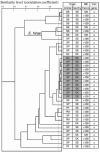Occurrence and relatedness of vancomycin-resistant enterococci in animals, humans, and the environment in different European regions
- PMID: 16151128
- PMCID: PMC1214655
- DOI: 10.1128/AEM.71.9.5383-5390.2005
Occurrence and relatedness of vancomycin-resistant enterococci in animals, humans, and the environment in different European regions
Abstract
Vancomycin-resistant enterococci (VRE) in Europe are thought to have emerged partly due to the use of the glycopeptide avoparcin in animal husbandry. We compared the occurrence of VRE in geographical regions of Europe in which until 1997 large amounts of avoparcin were used (Spain, United Kingdom, and Denmark) with the occurrence of VRE in Sweden, where avoparcin was banned in 1986. We also studied the relatedness between VRE strains from different regions and habitats. In total, 2,580 samples were collected from humans, animals, and the environment (soil, sewage, recipient water). VRE resistant to 20 microg/ml vancomycin were identified in 8.2% of the samples and were found most frequently in raw and treated urban sewage samples (means, 71% and 36% of the samples, respectively), pig manure (17%), and hospital sewage (16%). The proportions of VRE-positive sewage samples were similar in Sweden, Spain, and the United Kingdom, whereas pig feces and manure were more often positive in Spain than in Sweden (30% versus 1%). Most VRE were Enterococcus faecium carrying vanA, and computerized biochemical phenotyping of the isolates of different ecological origins showed a high degree of polyclonality. In conclusion, it seems that animal-associated VRE probably reflect the former use of avoparcin in animal production, whereas VRE in human-associated samples may be a result of antibiotic use in hospitals. Since there seems to be a reservoir of the resistance genes in all countries studied, precautions must be taken to limit the use of antibiotics and antibiotic-like feed additives.
Figures



Similar articles
-
High prevalence of vancomycin-resistant enterococci in Swedish sewage.Appl Environ Microbiol. 2002 Jun;68(6):2838-42. doi: 10.1128/AEM.68.6.2838-2842.2002. Appl Environ Microbiol. 2002. PMID: 12039740 Free PMC article.
-
Epidemiology of vancomycin-resistant enterococci in the community and the relevance of farm animals to human infection.J Hosp Infect. 1997 Oct;37(2):89-101. doi: 10.1016/s0195-6701(97)90179-1. J Hosp Infect. 1997. PMID: 9364258 Review.
-
Detection and characterization of vancomycin-resistant enterococci in farm animals and raw meat products in Italy.Microb Drug Resist. 2000 Winter;6(4):313-8. doi: 10.1089/mdr.2000.6.313. Microb Drug Resist. 2000. PMID: 11272260
-
Occurrence and spread of antibiotic resistances in Enterococcus faecium.Int J Food Microbiol. 2003 Dec 1;88(2-3):269-90. doi: 10.1016/s0168-1605(03)00190-9. Int J Food Microbiol. 2003. PMID: 14597000 Review.
-
Decreased incidence of VanA-type vancomycin-resistant enterococci isolated from poultry meat and from fecal samples of humans in the community after discontinuation of avoparcin usage in animal husbandry.Microb Drug Resist. 1999 Spring;5(1):45-52. doi: 10.1089/mdr.1999.5.45. Microb Drug Resist. 1999. PMID: 10332721
Cited by
-
VanA-type enterococci from humans, animals, and food: species distribution, population structure, Tn1546 typing and location, and virulence determinants.Appl Environ Microbiol. 2007 May;73(10):3307-19. doi: 10.1128/AEM.02239-06. Epub 2007 Mar 9. Appl Environ Microbiol. 2007. PMID: 17351100 Free PMC article.
-
Antimicrobial resistance of heterotrophic marine bacteria isolated from seawater and sands of recreational beaches with different organic pollution levels in southeastern Brazil: evidences of resistance dissemination.Environ Monit Assess. 2010 Oct;169(1-4):375-84. doi: 10.1007/s10661-009-1180-6. Epub 2009 Nov 11. Environ Monit Assess. 2010. PMID: 19904625
-
ε/ζ systems: their role in resistance, virulence, and their potential for antibiotic development.J Mol Med (Berl). 2011 Dec;89(12):1183-94. doi: 10.1007/s00109-011-0797-4. Epub 2011 Aug 6. J Mol Med (Berl). 2011. PMID: 21822621 Free PMC article. Review.
-
Genotypic diversity, antibiotic resistance and bacteriocin production of enterococci isolated from rhizospheres.Microbes Environ. 2012;27(4):533-7. doi: 10.1264/jsme2.me12041. Epub 2012 Oct 31. Microbes Environ. 2012. PMID: 23124764 Free PMC article.
-
Tackling antibiotic resistance: the environmental framework.Nat Rev Microbiol. 2015 May;13(5):310-7. doi: 10.1038/nrmicro3439. Epub 2015 Mar 30. Nat Rev Microbiol. 2015. PMID: 25817583 Review.
References
-
- Aarestrup, F. M. 1995. Occurrence of glycopeptide resistance among Enterococcus faecium isolates from conventional and ecological poultry farms. Microb. Drug Resist. 1:255-257. - PubMed
-
- Bager, F., M. Madsen, J. Christensen, and F. M. Aarestrup. 1997. Avoparcin used as a growth promoter is associated with the occurrence of vancomycin-resistant Enterococcus faecium on Danish poultry and pig farms. Prev. Vet. Med. 31:95-112. - PubMed
-
- Blanch, A. R., J. L. Caplin, A. Iversen, I. Kuhn, A. Manero, H. D. Taylor, and X. Vilanova. 2003. Comparison of enterococcal populations related to urban and hospital wastewater in various climatic and geographic European regions. J. Appl. Microbiol. 94:994-1002. - PubMed
Publication types
MeSH terms
Substances
LinkOut - more resources
Full Text Sources
Medical

